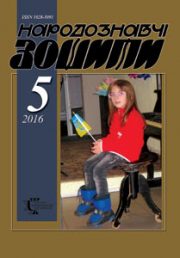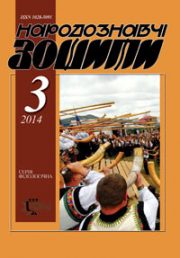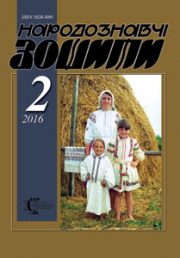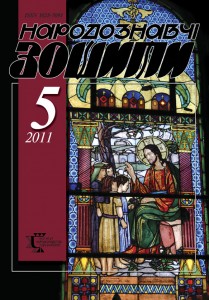2011 year, issue 5
Movna Uliana. On significative role of honey in ukrainian ritual text of birth. P. 755-759
The article has been concerned with symbolic role of honey in the context of Ukrainians’ birth rites and throws some light upon main semantic connotations of the product i.e. mediative, initiative, social, fertile, cathartic and apothropaic functions, as well as its ritual predestination as sacrificial matter. Significant function of honey has manifested itself through main structural elements of ritualistic birth text during delivery, the first visiting of young mother by rural women, the first bathing of new-born baby, baptismal and christening treat.
Keywords: honey, birth rites, ritual, «text», baptism, seman¬tics, mediator, Ukrainians.
Keywords: honey, birth rites, ritual, «text», baptism, seman¬tics, mediator, Ukrainians.
The author presents some results of her studies in components of wedding ritualism by Leopolitans during late 16 and early 17 cc.: matching, engagement, wedding ceremony and party. Especial attention has been paid to the significance of family in then-a-day urban community as well as to one of most ancient wedding forms as kidnapping of a bride.
Keywords: wedding ceremony, ritual, engagement, family, townsfolk, Lviv.
Keywords: wedding ceremony, ritual, engagement, family, townsfolk, Lviv.
Horbal Maria. Hospitality as a paradigm of spirituality in Lemko Christmas ritualism. P. 772-776
Phenomenon of hospitality as a paradigm of spitituality in Lemko Christmas ritualism has been considered in the article. Basic ground of hospitality had been lain in our people’s spirituality that owing to genetic memory survived till nowadays since pagan era and by means of Christian beliefs, in particular by Biblical teachings has come to us.
Keywords: hospitality, invitation, Christmas supper, souls of dead relatives, Christianity.
Keywords: hospitality, invitation, Christmas supper, souls of dead relatives, Christianity.
In the paper author has published his field ethnographic materials gathered on the borderland of Boyko Region and Pidhirya mountain slopes. The researcher has brought her analyses in different constructions used as places for storage and saving products of agriculture, as well as for stockkeeping and another building of the farm. Detailed descriptions have been given of constructive peculiarities as for most interesting objects. In the article has been forwarded an idea that in studied territory still are present some particularities of traditional folk culture, as e.g. those in the sphere of household. The necessity of further studies is therefore being explained.
Keywords: traditional culture, material culture, household buil¬dings, barn, threshing barn, haystack, cellar, cattle-shed, fence.
Keywords: traditional culture, material culture, household buil¬dings, barn, threshing barn, haystack, cellar, cattle-shed, fence.
The point of this article is Wałbrzych and its surroundings — a place where the heaviest page of changes in Poland after 1989 had been written. During several recent years Wałbrzych became a basin of illegal un-industrial coal-mining.
Keywords: Wałbrzych miners, mines, garbage, treasure.
Keywords: Wałbrzych miners, mines, garbage, treasure.
The article based upon ethnographical field research-works fulfilled among Ukrainian and Romanian population of villages in Storozhynetsky region during 2008—2011 has brought an attempt to explore the reminiscences of the complex customs and rituals associated with childbirth through prenatal, obstetric and postnatal periods.
Keywords: custom, rite, childbirth, Storozhynetsky region, Ukrainians, Romanians.
Keywords: custom, rite, childbirth, Storozhynetsky region, Ukrainians, Romanians.
The paper deals with the use of products of hunting in traditional material and spiritual culture by Ukrainians of Carpathians. In his study the author pays special attention to mountaineers’ customs concerning their nutrition with wild animal and bird meat, as well as their usage of skins, bones, feathers; he also describes the appliance of hunting spoil in traditional medicine widely spread during the second half XIX and the first half XX cc. In conclusion the explanation has been forwarded as for circumstances owing to which arose quite distinct differences in levels of usage of products in material and in spiritual culture:
Keywords: hunting, tradition, material culture, spirituality, ritua¬lism, medication, nutrition, population, Ukrainian Carpathians.
Keywords: hunting, tradition, material culture, spirituality, ritua¬lism, medication, nutrition, population, Ukrainian Carpathians.
Lviv cultural life during the period of XVII and XVIII cc. had been formed under the influence of Western European creative and artistic processes that found their most distinctive expression in Baroque styling. In the article has been made a review of mentioned historical period through the prism of social events and cultural artistic processes. In review have been used factual data; analytic studies of artifacts have been performed.
Keywords: secularization, ideological and artistic problems, the plastic arts, the style system.
Keywords: secularization, ideological and artistic problems, the plastic arts, the style system.
In the article have been considered some formative processes in creation of Holy Virgin — Rus’ type in the Kyivan Rus’ — Ukrainian art through contextual meaning of a monumental image.
Keywords: image, epoch, iconographic type, reflection, evolution.
Keywords: image, epoch, iconographic type, reflection, evolution.
In the article have been considered some trends of historicity and eclecticism in aesthetical system of royal doors at Voskresensky cathedral of Rivne, Uspensky cathedral of Volodymyr-Volynsky, Bohoyavlensky cathedral of Ostroh, Svyato-Troyitska church of Mezhyrytsky monastery, Troyitska church of Svyato-Mykolayivsky Horodotsky monastery, Mykhailivska church of Hoshcha and St. Peter and St. Paul church of Mykhnivets in Volhynia. Period covered by present study had lasted during the second half XIX and the first third XX cc.
Keywords: historicity, eclecticism, stylistics, aesthetical system, interior, iconostasis, royal gates, Volhynia, Ukraine.
Keywords: historicity, eclecticism, stylistics, aesthetical system, interior, iconostasis, royal gates, Volhynia, Ukraine.
In the article have been presented paintings by our contemporary, Lviv artist Lubomyr Medvid in the temple of St. John the Baptist and the church of St. Apostle John the Theologian, Village of Sukhovola near Lviv. In our nowadays church polychromy these works introduce the spirit of true creativeness and correspondence to the canons of Christian confession.
Keywords: Christ-Pantocrator, polychromy, light and shade.
Keywords: Christ-Pantocrator, polychromy, light and shade.
Yamash Yuri. On Ivan Trush genre palette. P. 850-856
In the article author brings definitions and concretizations as for genres of Ivan Trush’ paintings as well as exacted list of thematic cycles and series that form the artist’s creative work.
Keywords: painting by Ivan Trush, genres, cycles, series.
Keywords: painting by Ivan Trush, genres, cycles, series.
The article has been focused on studies in artistic and stylistic peculiarities of visual advertising in Ukraine. It throws some light upon certain trends in development of stylistic features of fine art photography used by visual advertisers and analyses the usage of photo artifacts via studying the samples of contemporary advertisements.
Keywords: visual advertising, fine art photography, Ukrainian advertising photography, advertising agencies, visual means, advertising companies, consumer.
Keywords: visual advertising, fine art photography, Ukrainian advertising photography, advertising agencies, visual means, advertising companies, consumer.
Mariana Dziuba. On Vira Tarasenko’ life and creative work. P. 872-876
The present article has brought studies in formation and works of Vira Tarasenko, Sambir pedagogue and self-taught artist by vocation. She’s quite original personality in her search for individual approach to problems of contemporary art who has given proves of her gift in different genres, especially in landscapes. Light has been thrown upon her exhibitive activities as well as her social credo.
Keywords: artist, work, creativity, genre, theme.
Keywords: artist, work, creativity, genre, theme.
Rusina V. Drawling folklore songs of Luhansk land (case study 2010). P. 877-883
The article brings study as for the actual state of sung folklore in Luhansk region. The data had been gathered during expedition in rural areas of Luhansk region at 2010. The records have been sorted according to genre and repertory aspects. The problem concerning a character of chant by informant groups of various age that demonstrate quite different types of the music thinking — «old» and «new» ones — has been introduced.
Keywords: Ukrainian folklore song, drawling chant, tradition, Sloboda land, Luhansk region, field research.
Keywords: Ukrainian folklore song, drawling chant, tradition, Sloboda land, Luhansk region, field research.
«Nova Khata» («New Home») had been an organ of «Ukrayinske Narodne Mystetstvo» («Ukrainian Folk Art») Lviv feminine manufacturing cooperative and belonged to the wide range of Western Ukrainian periodicals that at the first half of XX c. firmly stood for the national distinctness of Ukrainians under conditions of statelessness and expansion of foreign cultures. The cooperative worked on formation of peculiar Ukrainian modern style in clothing as well as in arrangement of homes and temples upon the basis of native traditional art. Launching the Ukrainian womanhood’s active position had also been among principal tasks of the magazine.
Keywords: Lviv magazine «Nova Khata» («New Home»), women cooperative «Ukrainian Folk Art», Ukrainian fashion, Ukrainian embroidery.
Keywords: Lviv magazine «Nova Khata» («New Home»), women cooperative «Ukrainian Folk Art», Ukrainian fashion, Ukrainian embroidery.








